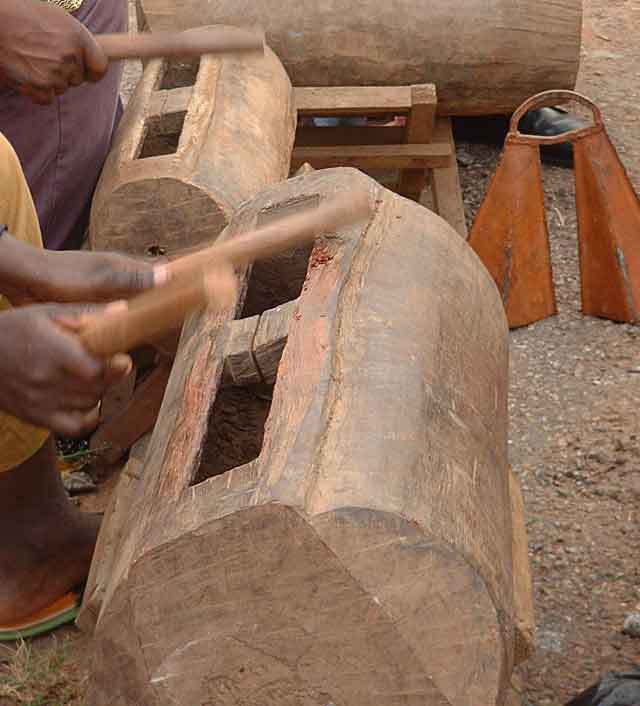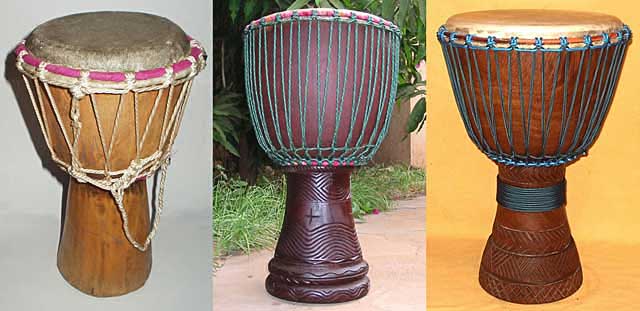Africa’s Musical Message Drums
Talking Drums Have Rhythm
As a young boy in the bush, I had a Shangaan friend who was 5 years older than I. It stands to reason; he became my Bushveld tutor, who also introduced me to African musical instruments. One day, he trotted out a homemade guitar with a whittled wood neck, obtained from the bush, attached to a one gallon (5 lt) petrol (gas) tin, with metal strings and flattened nails secured into the wood for frets. He also made two string puppets (marionettes) that dangled off the end of the guitar neck, which he made dance to his tunes. Why is he important to this story, you may ask? It show that even at an early stage in one’s life hidden talents are forming our future.
At this time my friend was a young apprentice message drummer at the time and I was told very talented. One day he told me how he was going to study it properly when old enough, since it was a five year apprenticeship he had to complete first. He did and became a very well-known drummer in the Timbavati region. Of course, no one did anything in or around about the reserve, without him either knowing or being told by other drummers in the district. A good friend to have if you’re keeping up with local news.
Interestingly, messages using talking drums are rhythmically played out in the form of poetry, jingles, or folktales. Take this for an example, a message to someone who must go via the shops and buy bread on their way home. Instead of drumming, “Sam, get bread on your way home,” what is in fact drummed is, “Sam, Sam the pantsula man, the cupboard is bare and bread is what we need, so dance your way past the shops.” This would be a passage from a well-known folktale familiar to the listener and therefore perfectly understood. Anyone not familiar with this folktale would obviously not understand what was being played.
Many such appealing messages were strung together, to the drummer and the listener’s enjoyment, in order to convey what was meant. Drummers, as you can imagine, get to know one another very well and therefore complicated messages were easily engineered by talented drummers.
What distance, you say? Well a log or slit gong was made from large to small and the large ones could drum messages incredible distances. Some say more than 20 miles in the bush and a lot further in the mountains. I have heard large drums clearly as far as 12 miles at night in Timbavati. Also remember, sound travels a lot further at night, when the talking drums are mainly used. Also consider it takes a trained ear to hear the drum at very great distances.
It’s a Kings Business
In the days of the African kings and their courts, more than one drum messenger was employed by the king and always kept close at hand. Whatever the king required to tell his kingdom or neighbors was instantly drummed out. It is otherwise often referred to as Drum Telegraphy. An example of the talking drums was clearly displayed through people like Dr Livingston and Pr Robert Moffatt. Stanley; the man who found Dr Livingstone in the remote jungles of Africa, became famous as an explorer and journalist for his trip up the Congo river in search of one lost man in Africa. He was both amazed Livingston was not lost and astounded to note all the villagers knew of his arrival well in advance.
It would have been good if Queen Victoria had her own drummer. Imagine the confusion it would have prevented. The modern world never understood what the talking drums were about, until 1914 when James Carrington a 24 year old missionary to the Congo wrote his book “The Talking Drums of Africa” published in 1949. Also see this new update in this Gutenberg entry.
In Livingston’s day, the king of the most powerful tribe in the region gave an order through his drums to all concerned, that he the king, vouched for these men. And in this way, instructing everyone to help them, when they arrived in their particular area. The result; these men got safe conduct wherever they went and the king was kept up to date with their daily travels. Messaging also aided in reverse, when threats of attack were discovered. From this and other examples you can see, the white men in early Africa, where totally unaware of the talking drums.
Many travelers penned the mysterious question of how everywhere they went in Africa; everyone seemed to know who they were, without anyone going ahead to announce their coming? Obviously in war time, talking drums were a powerful instrument in the hands of a tactical commander. Africa might have been dark, but not blind to its goings on. It was almost like having a cell phone in the dark ages. What a secret weapon to have.
Did it ever go wrong for the people? Well like all good things, there is apt to be the bad side. The slave traders used the message drums to great effect for their nefarious activities by sending false messages to trap their prey. So effective were they, that many drummers were captured and unknown to their captors, sent to the new world. Drummers were skilled drum makers themselves. The result was, talking drums became such a problem in Cuba and the islands that drumming was simply banned to keep order.
By the early eighties, – before the days of cellphones – I’d not had contact with my Shangaan friend for nearly fifteen years. And it was on this occasion I found myself in the Hoedspruit area, looking for property to buy and took the family on holiday as well. While driving around on the Western side of the Olifants River spying out the land, we arrived at a farm with a sign on the farm gate, advertising it for sale. I liked the look and went in; arriving at a well-executed camp next to the Olifants River, where we were met by a camp minder.
After greetings and whys and wherefores were exchanged, this man knew who I was and where I came from, plus a lot more. I laughed and told him how he knew; he in turn had his fun and said indeed, it was my old friend the drummer who also sends greetings and welcome. At this time my friend lived about 80 miles (130 km) north and we lived 350 miles (580 km) west. So how he knew we were in the area, I don’t know. This was obviously a general message to the area from my friend, who this man had heard, himself also a drummer. I thanked him and jokingly told him to tell my friend to stop spying on me.
The term “Jungle Drums” is well fitting, in the sense that it means gossip drums. I suppose this could easily develop, given the drums versatility of use, like calling the people to gatherings and parties. I think a lot of people living in Africa, have no idea how much is known about them, via the secret people of the talking drums. It would shock a westerner of how many and how much the drums interact in many African tribes. There are dancing, message, social, wedding, burial, party and many more different kinds of drums, that you could not imagine, even when you are in that community as a visitor. Drums are definitely a part of the community you need to grow up with, to know and understand them.
The following video, well displays the versatility of the djembe drum in the hands of an expert drummer. You will have no trouble understanding this message.
Video Run Time: 2:53 min


